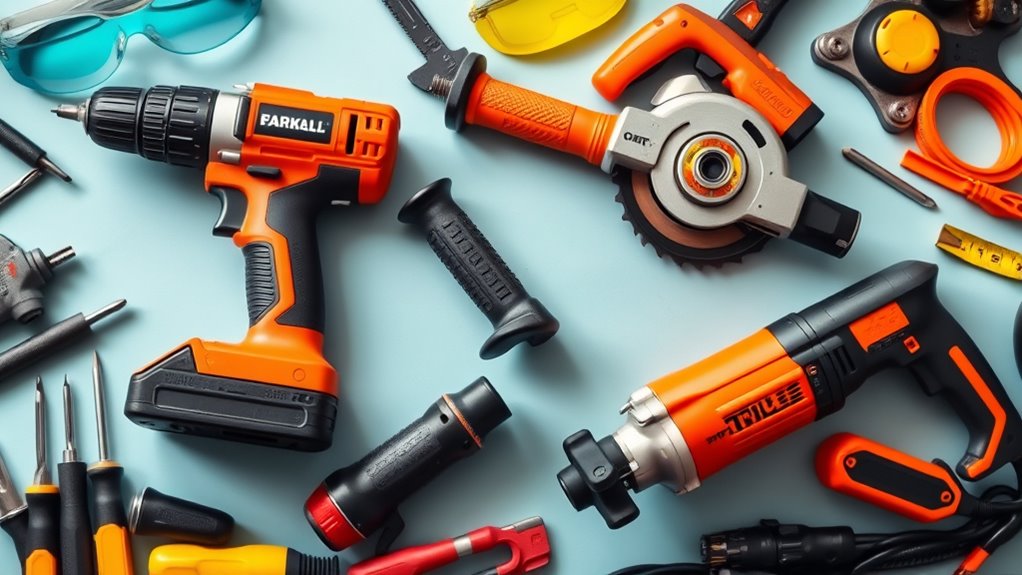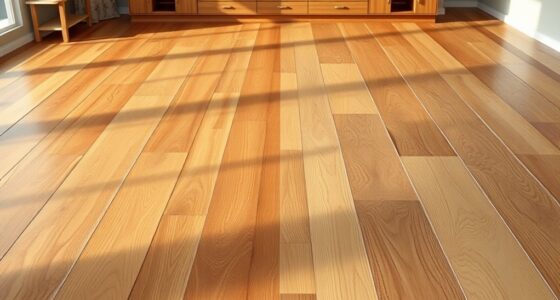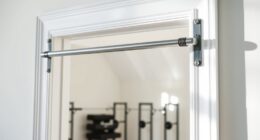Starting your home improvement journey? Focus on essential power tools like a cordless drill, saw, and multi-tool, choosing reliable brands that balance performance and cost. Always wear safety gear such as glasses and gloves, and keep tools well-maintained and organized. Whether you rent or buy depends on how often you’ll use them—smart choices save money and effort. Keep exploring tips for building your toolkit, safe usage, and project ideas to become confident in your DIY skills.
Key Takeaways
- Essential power tools for beginners include cordless drills, saws, and multi-tools, chosen based on project needs and safety features.
- Consider rental versus ownership by evaluating tool frequency, cost, and project scope to build an affordable toolkit.
- Prioritize safety gear like glasses and gloves, and maintain tools regularly to ensure longevity and safe operation.
- Organize tools with pegboards, storage boxes, and proper labeling to improve efficiency and safety in your workspace.
- Start with simple DIY projects such as painting or fixture updates, then progress to more complex home improvements using your power tools.
Understanding the Core Power Tools for Beginners

Are you new to power tools? Understanding the core tools is essential for your DIY projects. A cordless drill/driver is a must-have for drilling holes and driving screws in various materials like wood, metal, and plastic. Its adjustable torque settings help prevent stripped screws and surface damage, while variable speeds give you control. Lithium-ion batteries provide longer-lasting power and quick recharges, making your work more efficient. Compact, lightweight models are perfect for beginners and tight spaces. A circular saw allows you to cut straight lines quickly through plywood and lumber, with multiple blades for different materials. Its straightforward design makes it accessible for beginners. These tools lay the foundation for safe, effective home improvement projects, giving you versatility and confidence. Incorporating safety precautions into your tool usage ensures a secure and successful DIY experience.
Selecting the Right Brand and Performance Balance

Choosing the right power tool brand involves balancing reliability, performance, and cost to suit your needs. Look for brands with a solid reputation, as they tend to offer more durable and dependable tools, essential for long-term projects. Reading customer reviews and professional endorsements helps you gauge real-world performance. Consider warranty and customer service policies, which impact post-purchase support. Compatibility with existing batteries and accessories can save money and streamline your toolkit. Entry-level brands like Black+Decker are affordable and suitable for basic tasks, while mid-range options like Ryobi provide better durability. Premium brands such as DeWalt and Makita deliver high performance for frequent or heavy use but come at a higher cost. Match your choice to your project demands and budget for the best performance-to-price balance. Additionally, understanding the importance of vibrational energy can help you select tools that promote a positive working environment and reduce fatigue during extended use.
Essential Safety Gear and Maintenance Tips
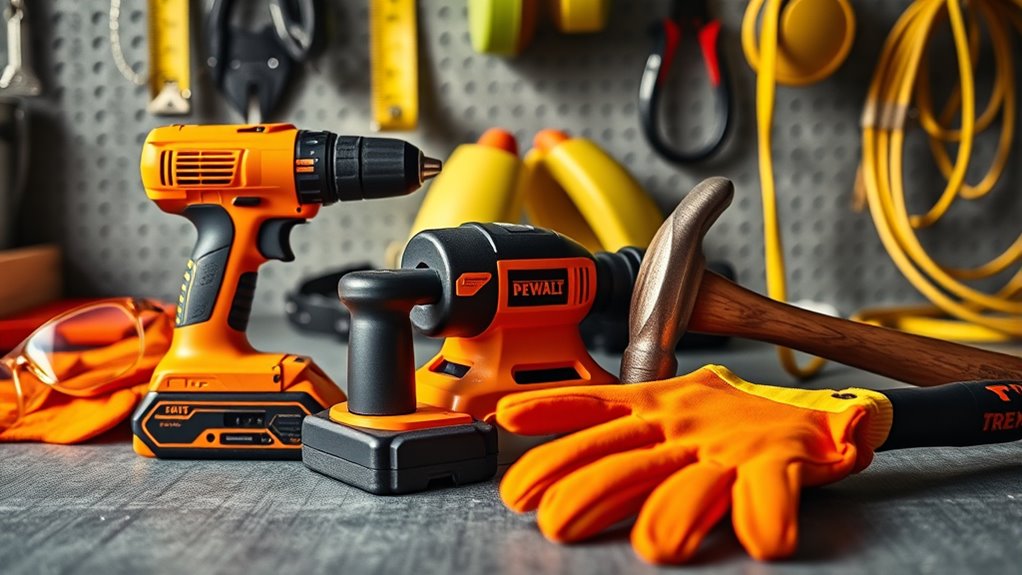
To work safely with power tools, wearing the right personal protective equipment (PPE) is essential. Safety glasses or goggles shield your eyes from flying debris, preventing injuries. Ear protection like earplugs or earmuffs reduces the risk of hearing loss from loud noises, especially with tools like saws. Respirators or masks (N95, P100) guard against dust, fumes, and particles during sanding or cutting. Work gloves protect your hands from cuts, abrasions, and heat when handling sharp or hot materials. Hard hats and steel-toed boots provide additional safety from falling objects and heavy loads, particularly on construction sites. Ensure your PPE fits well—loose gear can cause accidents, and low-quality gear may fail when needed most. Regularly inspect and maintain your safety equipment to keep it effective and reliable. Proper PPE use significantly reduces the risk of long-term health issues and injuries during DIY projects, especially when handling power tools.
How to Choose the Best Tool for Your Projects
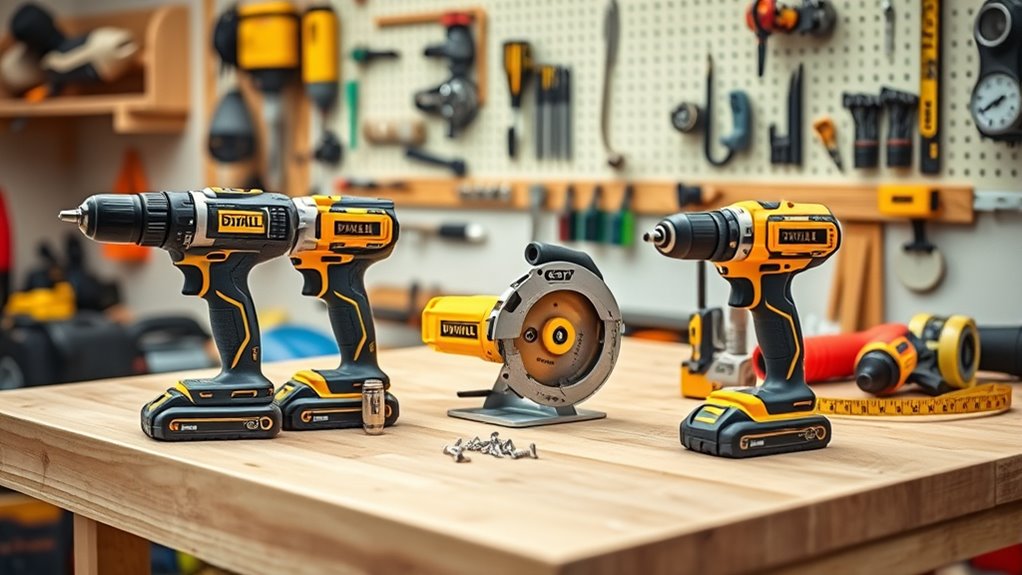
Selecting the right power tools begins with understanding your project needs and the specific functions each tool offers. First, identify whether your task involves simple repairs or complex woodworking, guiding you toward manual or power tools. Next, consider the power source: cordless models provide portability, ideal for quick jobs, while corded tools deliver consistent power for heavy-duty tasks. Third, evaluate key features such as adjustable speeds, ergonomic grips, dust collection, and easy blade changes to improve efficiency and comfort. Additionally, understanding aura colors and their meanings can enhance your awareness of energy dynamics in your workspace, leading to a more focused and harmonious environment. Finally, factor in brand reputation and value—reliable brands like DeWalt offer durability, and reviews help assess quality. Choosing the right tools also depends on understanding the different features and safety options available, ensuring you select equipment that is both effective and safe to use. By aligning your project scope with these criteria, you’ll select tools that match your skill level and ensure successful results without over-investing.
Practical DIY Projects to Get Started

Getting started with DIY projects can be both rewarding and budget-friendly, especially when you focus on simple tasks like painting or installing new fixtures. Painting interior walls is a quick way to brighten a room, while updating exterior brick boosts your home’s curb appeal—just be sure to prep surfaces properly. Painting a door adds color and style with minimal effort. When choosing paint colors, consider how hues influence the room’s ambiance. Essential flooring projects, like installing tile, can improve durability and style; use adhesive and grout for a professional look. Decorative elements, such as installing panel moulding or hanging ceiling medallions, add architectural interest. Updating fixtures by swapping handles or installing new lighting with power tools can refresh your space efficiently. Incorporating home improvement knowledge can help ensure these projects are successful and safe. These projects provide a solid foundation for your DIY journey. Help friends or neighbors with renovation projects to gain hands-on experience and ask questions.
Renting vs. Buying: Making Smart Tool Investments
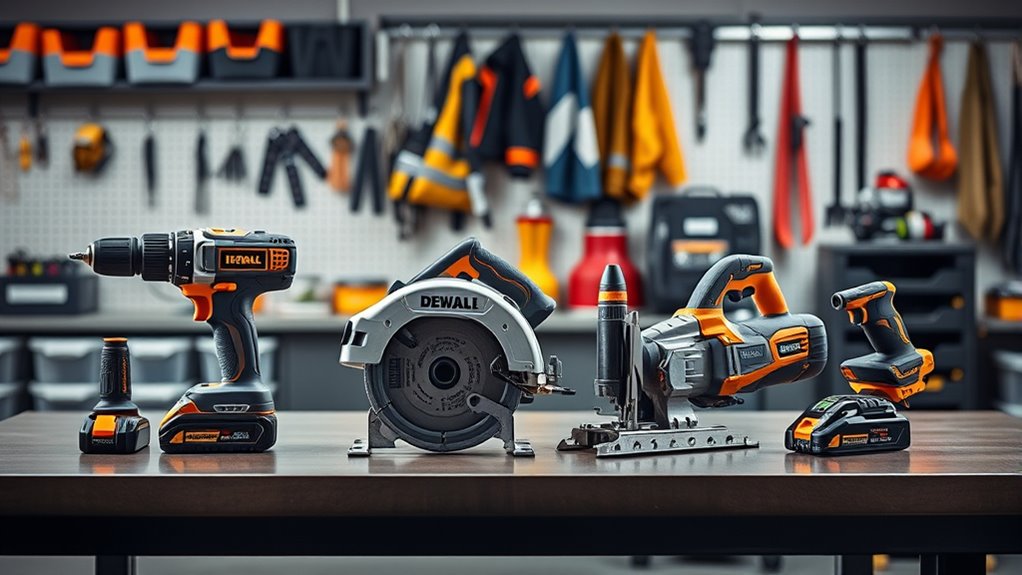
When deciding whether to rent or buy power tools, you need to weigh the costs based on how often you’ll use them. Renting can save you money for infrequent projects, while buying might be more economical if you’ll use the tools regularly. Consider your project scope and budget to make the smartest investment. Additionally, evaluating the maintenance and repair costs associated with ownership can help determine whether renting is a more practical option for your needs. For those interested in creating a functional and charming farmhouse kitchen, investing in quality tools can help with projects like cabinetry, shelving, or even DIY textiles.
Cost Considerations
Deciding whether to rent or buy power tools depends on your project needs and budget. Rental options usually have lower upfront costs, making them ideal for short-term projects. Buying involves a significant initial investment but can save money if you frequently use the tools. Consider these factors:
- Rental fees can add up, potentially surpassing purchase costs over time with regular use.
- Ownership incurs ongoing expenses like maintenance, storage, and insurance, which rentals often cover.
- Renting provides access to specialized or high-end tools without the long-term commitment.
- Buying offers immediate availability and avoids scheduling delays but ties up capital and involves depreciation.
- Additionally, some tools are best rented because they are large, costly, or used infrequently, making ownership impractical for most homeowners.
- Understanding the durability and lifespan of tools can help determine whether investing in ownership or opting for rental is more cost-effective, especially considering tool longevity.
Balancing short-term project demands with your long-term plans helps determine the smarter investment, whether renting or buying.
Usage Frequency
Most users prefer to use equipment they already own for their projects, especially when they require frequent access, reflecting a strong tendency toward ownership. If you plan to work on projects regularly, owning tools often makes sense for quick, reliable access. However, rental remains popular, with 74.5% of people renting at least once annually, mainly for short-term or infrequent tasks. Here’s a quick look at usage patterns:
| Usage Frequency | Ownership Preference | Rental Justification |
|---|---|---|
| Frequent | Prefer owning | Not necessary or cost-effective |
| Infrequent | Rent for short-term | Need for specialized tools |
| Occasional | Mix of renting and owning | Flexibility in projects |
| Regular | Usually own | Long-term projects |
Balancing these factors helps you make smarter tool investments. Understanding usage patterns can help optimize your investment in power tools to match your specific needs.
Budget-Friendly Options for Building Your Toolkit
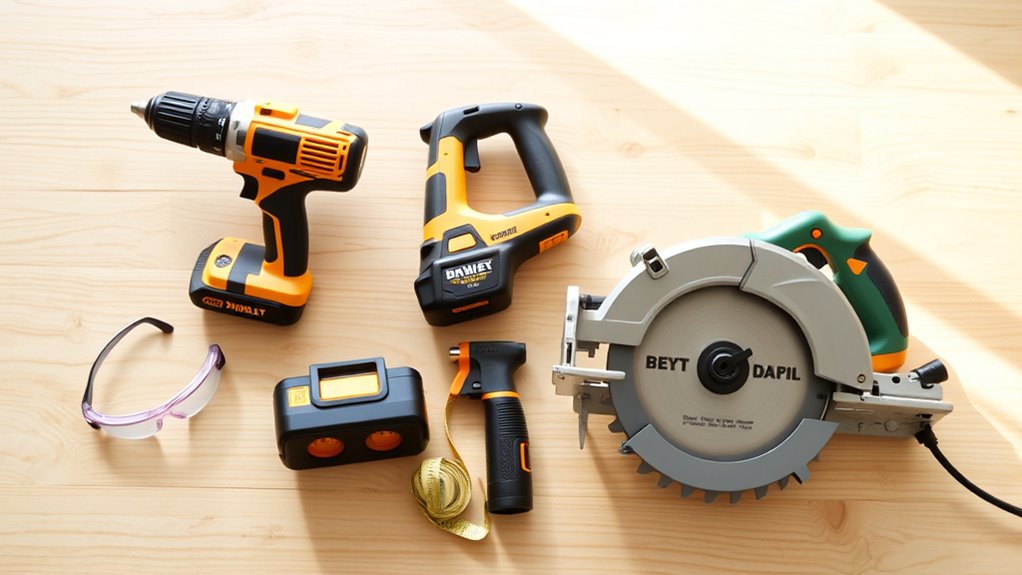
Building a budget-friendly toolkit is easier than you might think with a few smart choices. Focus on versatile, reliable tools that cover multiple tasks. Here are four essential options:
- Cordless Drill/Driver – Affordable models like DEWALT or Ryobi offer great performance for drilling and screw driving, often including a variety of bits and a lithium-ion battery. Cordless drills are among the most versatile power tools for beginners. Their adaptability makes them a cornerstone for various home improvement projects.
- Oscillating Multi-Tool – Compact and multifunctional, it handles cutting, sanding, and scraping, with starter kits around $100. Incorporating airless paint sprayers into your toolkit can further expand your capabilities, especially for painting large surfaces efficiently.
- Beginner Saw – Miter saws and circular saws start at $70–$150 and are perfect for straight cuts and trim work.
- Basic Accessory Sets – Drill bits, screwdrivers, and sanding pads are inexpensive, versatile, and essential for many projects.
Prioritize tools that deliver multiple functions to maximize your investment.
Organizing and Maintaining Your Power Tools

Keeping your power tools organized and well-maintained is essential for safety and efficiency. Use pegboard systems to hang tools like drills and saws, making them easy to find and access. Layered storage on rollers maximizes space and keeps tools mobile. Modular steel organizers are perfect for heavy-duty storage, while wall-mounted cabinets improve workshop layout. Incorporate adjustable storage slots to fit various tools. Create separate zones for different tool types and use open shelving for visibility. Leveraging proper storage techniques can prevent damage and prolong the lifespan of your tools. Regularly clean and inspect tools, store them in a dry environment, and lubricate moving parts. Proper organization and maintenance keep your tools safe, functional, and ready for your next project. Organizing tools into designated zones helps streamline workflow and reduces clutter, making your workspace more efficient.
Tips for Safe and Effective Tool Usage

To guarantee safe and effective use of power tools, always perform a thorough pre-use inspection. Check for damaged cords, loose parts, cracks, or missing safety guards. Remove damaged tools from service and tag them “Do Not Use” until repaired. Ensure cords are organized, properly labeled, and never carry or unplug tools by their cords to prevent electrocution. Secure your work with clamps or vises to keep both hands free and maintain control. Find good footing and stay balanced to reduce slips or falls. Additionally, always confirm the tool is off before plugging it in, and disconnect it before changing accessories or maintenance. Use PPE like safety glasses, ear protection, dust masks, and gloves suited to the task. Follow manufacturer instructions for safe operation and recognize electrical safety precautions. Proper workspace organization and adherence to safety protocols are essential for preventing accidents and ensuring a safe working environment.
Frequently Asked Questions
How Long Do Power Tool Batteries Typically Last?
Power tool batteries typically last around 2 to 5 years, depending on their chemistry and usage. Lithium-ion batteries are the most common and usually last 3 to 5 years with proper care. Nickel-Cadmium and Nickel-Metal Hydride batteries have shorter lifespans, around 2 to 4 years. Remember, frequent partial charges, proper storage, and avoiding extreme temperatures can help extend your batteries’ performance and lifespan.
Can I Use Any Brand of Batteries Interchangeably?
Battery brand banishes basic compatibility. You can’t just swap any battery into any tool because proprietary connection points, voltage variations, and internal electronics block cross-brand compatibility. While some brands offer within-platform interchangeability, using third-party adapters to cross brands carries risks. You might damage tools or void warranties. Always double-check voltage, connector compatibility, and safety features before attempting to interchange batteries, ensuring safe, smooth, and seamless power performance.
What Are Common Signs That a Power Tool Needs Maintenance?
You’ll notice your power tool needs maintenance when it starts losing power or slows down during tasks. Watch for visible damage like frayed cords, cracked handles, or rust. Unusual noises or excessive vibrations also signal issues. If it’s hard to start or doesn’t shut off properly, electrical problems might be the cause. Regularly inspecting these signs helps prevent breakdowns and keeps your tools running smoothly.
Are There Specific Safety Precautions for Cordless vs. Corded Tools?
Think of safety precautions as your shield when using power tools. For corded tools, always inspect cords for damage, keep work areas dry, and manage cords to prevent tripping. With cordless tools, regularly check batteries for leaks and damage, and avoid exposing them to extreme temperatures. Both require PPE like safety glasses and gloves. Whether corded or cordless, staying vigilant helps you wield your tools safely like a pro.
How Often Should I Sharpen or Replace Saw Blades?
You’re wondering how often to sharpen or replace saw blades. Typically, carbide-tipped blades can be sharpened 5 to 8 times, while bandsaw blades last through 6 to 8 sharpenings. Rip blades may last years between sharpenings. Pay attention to signs like slower cuts, chipped teeth, or increased effort, and sharpen or replace blades accordingly. Regular cleaning and proper storage help extend their lifespan, ensuring safe, efficient cuts.
Conclusion
So, now you’re all set with your power tools—ready to conquer every DIY project with confidence. Ironically, the biggest challenge might just be resisting the urge to turn every household task into a full-blown construction site. But hey, with your new kit and safety gear, you’re more than prepared. Just remember, the real power isn’t in the tools—it’s in your newfound DIY spirit. Now go ahead, build something amazing (or at least try to).
